Text
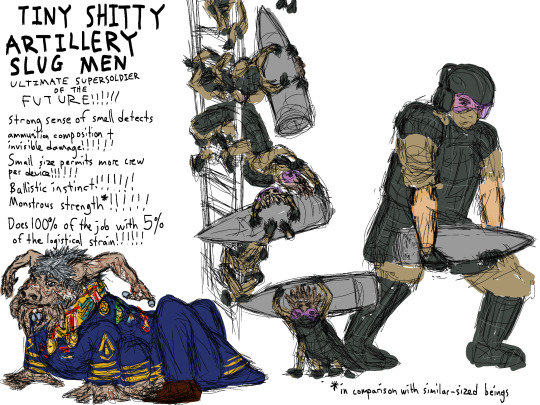
Thought experiment: an incredibly uncool non-aspirational supersoldier deliberately made smaller, weaker, and more annoying than the average human, but is still the most effective supersoldier type in their universe. The tiny shitty artillery slug man is based on the anatomy of ambush predator caterpillars.
8 notes
·
View notes
Text
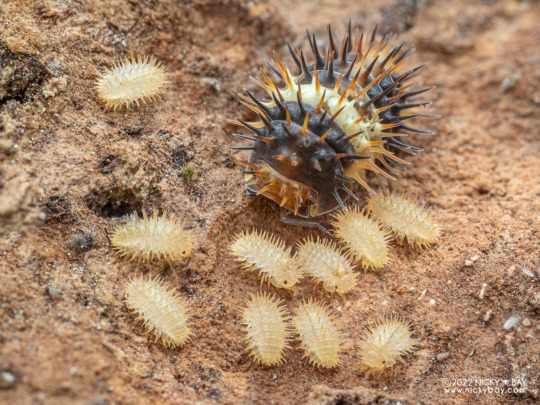
I don't think spiky isopods are talked about enough
(Source-Macro photography by Nicky Bay)
3K notes
·
View notes
Text

human in extraterrestrial fashion
from right to left:
rikka kkariko ceremonial wear - atil pet costume designed for humans - ki cosmonaut uniform, adapted for human anatomy - ki real physicist uniform.
rowny's favorite is the kkariko ceremonial wear!
#ki clothing is best for humans as they both have four limbs and an oblong body#but since ki are on average smaller than humans... they have to sew three ki uniforms together#atil tend to only use black white and red in clothing#this is because the only color their eyes can see is red#their tonal vision is pretty good tho. they can see black and white well#do you remember rrikrik's bib in their first portrait? those bibs are important in rikka culture#they denote somebody's clan. only somebody from a specific clan should wear that specific bib.#the bib that rowny is wearing is a generic type of bib that rrikrik made to represent the “rika” clan - kkariko mikkriko and grik krog#rrikrik says its ok if you wear it there arent really any other rikka cosmonauts nobody will know...#real physics is kewl but its hard to explain...#i cant believe i never posted this. this is OLD#i think some of the anatomy is funny but i still post it anyway#oc
3 notes
·
View notes
Text
its funny to me that patina is waving hello on my blog but ive never spoken about alerians here
0 notes
Note
you should make a species called shoeniima thats like uniima but shoe and it would be so cool you wold make millions of dolar and followers and be famous and rich and powerful
shoeniima
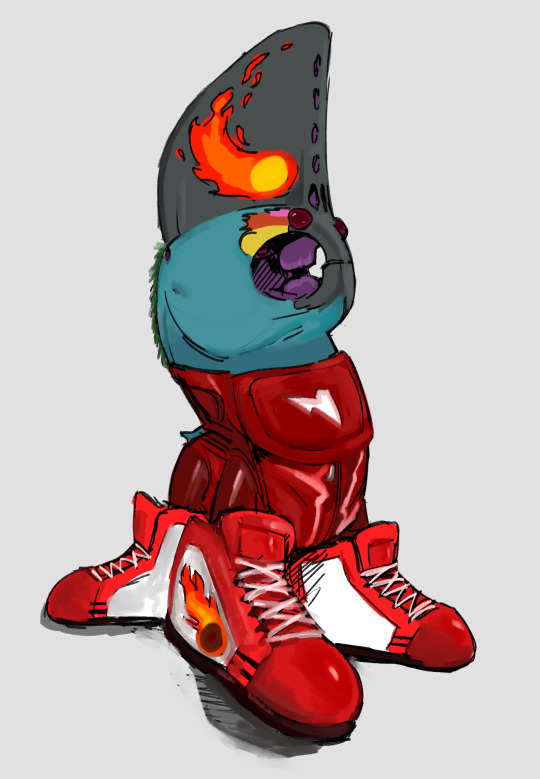
I know what you are
132 notes
·
View notes
Text


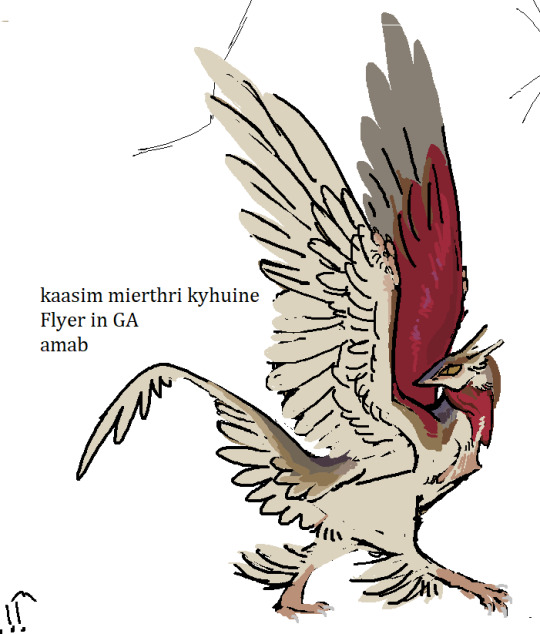
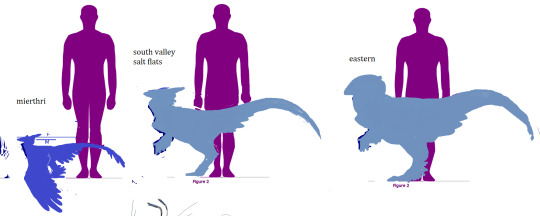

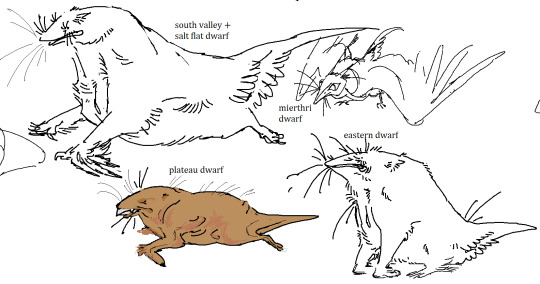
not so interesting sketch dumps cause i feel guilty about not posting today, last one is mythological kyhuine dwarves ideas




maanul faces dump, trying to have ocs with difference faces lalala
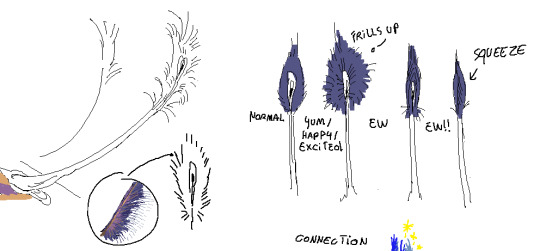
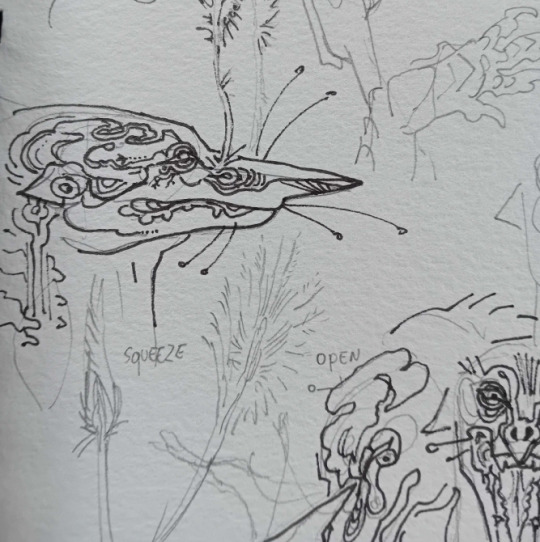
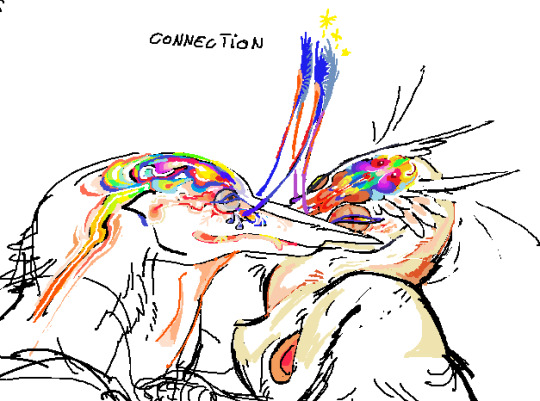
sketches for a wip text about new infos around tahofahs and how theywork, concepts about "mind gates" and exchanging infos. its already figured, already yapped to some friends about it, i just need to redo my text to be clean and coherent for normal people here
shitposts

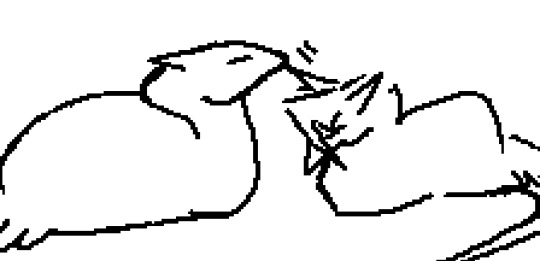

688 notes
·
View notes
Text
Xylovitria
This post is an overview of one of the "animal" phyla present on Almud. This is the first of many, since I do plan on making a similar post for each of the others. All art shown here was created using MS Paint, though I may switch to a different program if I find one that works better (probably Procreate, since I have recently bought it, but it's a bit hard to use with just a finger on a phone screen) (Also MS Paint has an AI generator thing now and that's very stinky and bad).
The first thing to cover is how the phylum came to be. Xylovitrians originated as an offshoot of vivitrians, specifically a freefloating colonial species analogous to a hard, glassy man o' war. Its body was hollow, with pores lining its outside to allow water in to be filter-fed through by its tendrils. A color-coded overview of its anatomy is shown below.

Purple: The glassy shells of each zooid. Forms a pocket for water to flow through.
Blue: Same as above, but in a different spot. I don't know why I colored this part differently, besides it being on the bottom. Too late to fix it sadly. MS Paint flattens layers after saving the image.
Red: The soft feather-like tendrils of each zooid. Responsible for filtering nutrients out of the water that flows into its body.
Orange: Also tendrils, but specialized for a different purpose. This thicker bundle not only filters through the water for nutrients, but produces gametes for sexual reproduction. Typically, though, the organism will just reproduce asexually by producing more zooids and splitting apart.
At some point very early into the history of Almudian life, a kelp-like plant species developed a habit of growing on top of these proto-xylovitrians, with their roots sometimes growing through the cracks and into the inner cavity. Here, the roots of the plant and the tendrils of the zooids would sometimes wrap around each other, forming a structure similar to Earth mycorrhizae. In a formation such as this, the animal would absorb some of the sugars from the plant's roots. In return, the plant would absorb some of the nutrients from whatever microorganisms got caught in the zooids' tendrils. This arrangement proved so mutually beneficial that this proto-xylovitrian species adapted an opening at the top specifically for the plant to grow through, and the kelp analogue adapted to only be able to grow on or inside xylovitrians.
The lineage did not stop developing here, however. One offshoot descendant of this proto-xylovitrian eventually adapted to live at the surface of the water, giving the resident plants much better access to the sunlight and gases necessary for photosynthesis. The plants, meanwhile, adapted to have sturdier stems and more water loss-resistant skin, as well as a new way of entering their host. The plants’ spores now enter though the side pores leading into the water cavity, where they will bloom without ever having lived outside. Below is a diagram of this new offshoot’s anatomy and what sets it apart from its ancestor.

Purple: Same as before, but with a thick, waxy coating on the outside to prevent water loss in the above-water level bits.
Blue: Same as before. Nothing to comment on. Only colored this part in differently for the sake of consistency.
Red: The inner zooids' tendrils have lost the ability to filterfeed. Instead, they get all of their nutrition from the plants' roots, which they are permanently wrapped around. The central cavity, despite being above water level, is also still filled with water, preventing the plants from dehydrating. The water is brought in through the side openings, which now also contain a pumping mechanism to prevent backflow. The entire structure is more or less a living vase now.
Orange: Same as before, but with some added features. Not only are the tendrils longer, but some of them have developed the ability to produce toxins. A few toxin-resistant, fish-like creatures use these areas as a refuge from predators, where they will also pick up some gametes which they will spread to the next set of tendrils they hide in, inadvertently acting as vectors for the xylovitrians' reproduction.
Yellow: A gas bladder, which lets the whole structure stay buoyant enough to not sink below the surface. Adapted from a mutated second central cavity.
Given that these are freefloating organisms, it was inevitable that some would eventually wash up on land, where certain adaptations, such as the waxy coating and the inner water cavity, would allow the xylovitrians and their plant partners to continue surviving and thriving. Without much risk of drying out, this small beached population continued reproducing on the muddy shore, gradually accumulating adaptations over the generations that made them even better at living on land. It is at this point that the first true xylovitrians emerged.

Below is yet another diagram, this time of a fully-terrestrial inland xylovitrian. The phylum's diversity exploded after the transition to land, so this isn't totally representative of all species, host or plant, but it's still a generally useful guide.

Purple: Same as before, but now there are sometimes additional openings at the top for the leaves of the plants to grow out of.
Blue: The siphons that connected the central cavity to the outside body of water have become their own separate organs, accompanied by root tendrils outside of the tube to make absorbing water easier.
Cyan: Rather than water, the central cavity is filled with what can be best described as a sort of nutritious goop. The plant gets all of its nutrition from here.
Green: This gland is responsible for producing the aforementioned nutritious goop. Like the water extractor organs, these are specialized chunks of the central cavity.
Orange: The larger bottom tendrils now not only absorb nutrients and produce gametes, but root the colony into the soil. These nutrients are used to nourish both the xylovitrian and the plants. Other than that, they have remained mostly the same, just more spread out.
Yellow: No longer necessary for flotation, the gas bladder now functions mostly as a lung.
Unfortunately, the new arrangement of parts, with the genital tendrils and water tubes both being underground, makes the old reproduction and ensporification method impossible. Fortunately, a new method was devised to replace it, allowing the phylum to live on.

Step 1: The plants and xylovitrians are fertilized individually of each other, with the plants exchanging gametes through the air on swirly reproductive branches and the xylovitrians doing so under the ground with extensions of their roots.
Step 2: An empty juvenile xylovitrian emerges from the ground, while the plants' reproductive branches develop large spores using the exchanged genetic info.
Step 3: One or a few of the plants' spores fall, float, or otherwise enter into the empty xylovitrian, aided by feathery extensions that catch them if they fall close to the brim. Upon reaching the goop pool within, they will germinate, signalling the xylovitrian to continue its development.
Step 4: The new organism pair has been fully established, ready to one day do the same as their respective parents.
Notably, this specific method allows for different species of guest and host to mix and match, since different pair types are often similar enough to be compatible. This is not possible with every species, but it's a common enough phenomenon to where it's worth mentioning.
This is not the only dispersal method that exists, though. One group has adapted to be able to merge the xylovitrian embryos and plant embryos into a single seed, suspended in a sugary slime with a consistency and flavor similar to that of fruit gummies. Admittedly, I haven't fully thought through the mechanics of how this works, so I'll have to revisit it later. Until then, here's a very basic diagram.

Purple: Xylovitrian embryos
Blue: Plant embryos
I may edit this post later to add on or revise details if I feel like anything could be improved. I will also almost definitely make individual posts for specific species or families of xylovitrians that I feel like showing off. This is the end for now, though.
3 notes
·
View notes
Text
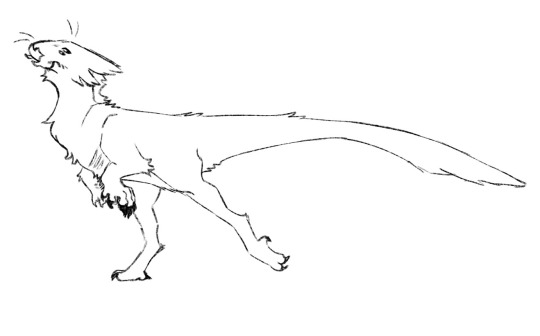
Little doodle of a new alien species I’ve been working on!
Hopefully I’ll have some more stuff to post abt these guys soon ;)
72 notes
·
View notes
Text

I started this a while ago, but entirely forgot this existed so it was never finished or posted unfortunately :/
It’s one of the “snailiens” painting details on a temple. The artwork above him depicts a snailien below a glyph of the sun.
Anywho, thank you all so much for all the love on my previous posts. I truely appreciate every interaction with my art :))
107 notes
·
View notes
Text
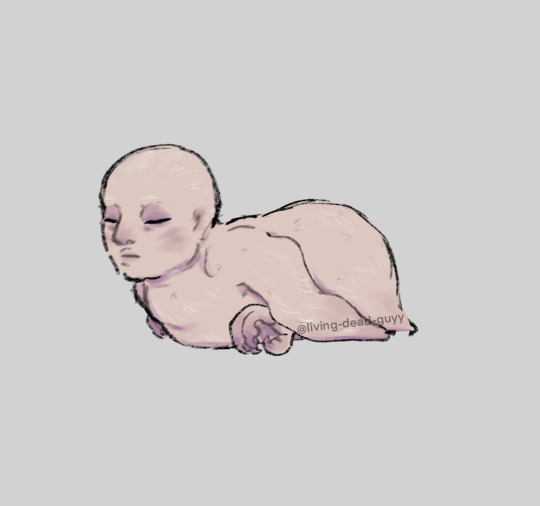
this is what happens when I am allowed to get bored
17 notes
·
View notes
Text
“Mirifia”
These are two orders of northern animals that are rather difficult to classify. They are not closely related to the Lunidae, Lunidatadae or the Xenocarnivora, nor are they closely related to each other. They likely represent two other lineages that independently arrived in the north in an unknown migration event. Because of their confusing origins and lack of relationship to other northern animals, they are classified together for convenience.
Hammerheads

Pictured: the saddled hammerhead, a species found on the plains around the Moonland Peaks.
Named for rather obvious reasons, the hammerheads have elongated, compressed heads with no upright crest. Instead, the ear is a flat membrane on top of the head, possibly indicating a relationship with the Polydigitae of the south. The eyes are positioned on the stalks, allowing them an almost 360-degree field of vision. These animals are rare, living in small, isolated populations across the plains. Because of this, much is still unknown about them, and researchers are taking an interest in these strange beasts and possible conservation efforts.
Spindles
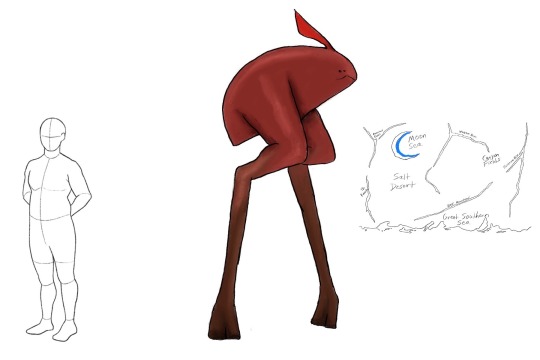
Pictured: the Red Spindle, the only formally named species, can be found throughout the densest forests surrounding the Moon Sea.
With long, thin legs and a bizarrely round body, the Spindles are found in thickets around the Moon Sea, using their height to pluck leaves from the tops of trees. Because their body is so high off the ground, they present a difficult target for predators and thus are not on the menu very often. Even so, they are incredibly elusive and shy, and do not cope well with habitat disturbances. Their current population is unknown, and only one species is formally recognized at this time but several subspecies have been proposed.
16 notes
·
View notes
Text
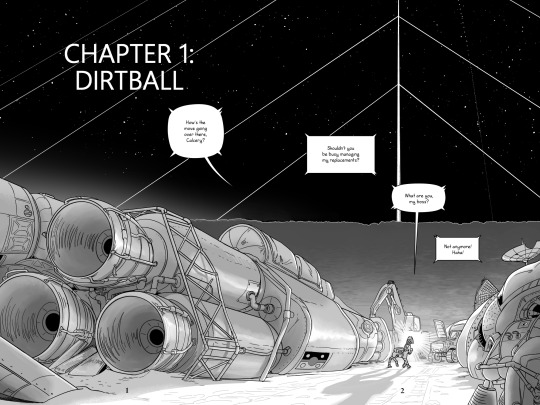


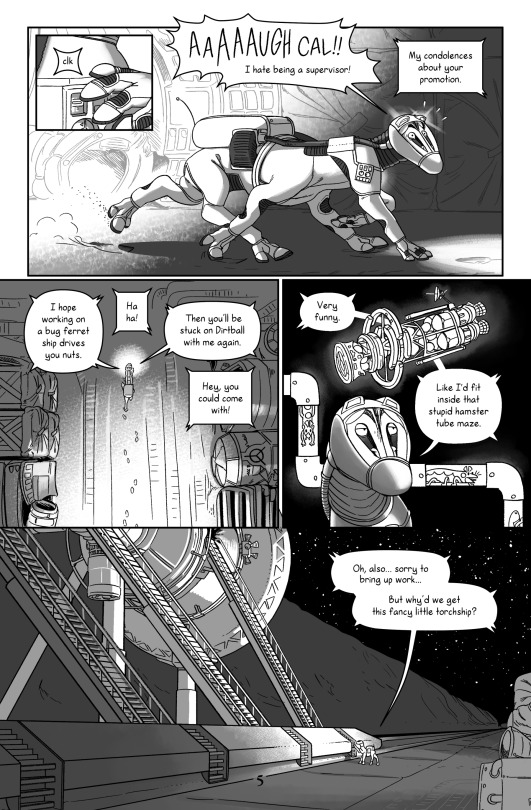
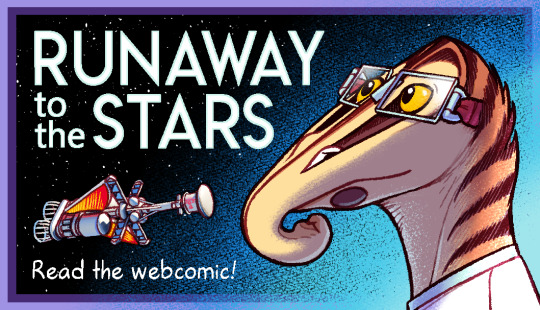
I finally (got help) slapping Wordpress into shape and Runaway to the Stars is now releasing as a public webcomic! Thank you so much for your support over the years, and sticking with me while I'm slowly chewing my way through this book. I'm very excited to share this story! It'll be updating every Tuesday, Thursday, and Saturday thanks to the massive Patreon backlog. Patreon will continue to update as I finish pages, which happens on a sporadic non-schedule.
If you experience bugs with the site report them to me. Some things may occasionally break, as coding problems tend to be a very "whack-a-mole" affair; and I'm still getting used to the interface.
7K notes
·
View notes
Text
Made a thing of an intercom announcement in a teleportation warp hub, because I can. Probably could've done better, but I need to use the best take the moment I get it. Here's a transcription and translation:
"Asl nliwayeğo cu-Vulvren cu-Lijaxel cāza-Vofağláf, vujt'al cu-Livmanznaf cu-Łt'ējn: tsa-levp'ā cu-lezrağn cu-ācèya, āgxōnr azmvlacwœ tcē-yú-wal xel-Verel fr-lce cu-abravrk'ūn pux-lejni tsa-lce yú. Má ēdzējağleyāf cu-flacwœ tcē-yú-wal xel-flacwœ ālxōr. T'ezl ēzr̄fl pi-lisa, má ēdzējağleyāf cu-flacwœ tcē-yú-wal xel-flacwœ ālxōr. Lcanznin tlezn tsa-avren fl. mVulvren cu-Lijaxel cāza-Vofağláf cu-stux ‘ōf tsa-levp'ā nar nedzasláf kxun-flacwœ, kā tcān danloxel cni-lesar tsa-zāsláf."
"This is an announcement from the Department of Interplanetary Transportation, a subdivision of the Ministry of Progress: due to system malfunctions, gate 2-1-3 bound for Erel at 16:00 has been delayed by one hour. All passengers boarding gate 2-1-3 must proceed to gate 16. Once again, all passengers boarding gate 2-1-3 must proceed to gate 16. Our deepest apologies for this inconvenience. Thank you for teleporting with us today, and we hope you have a safe warp."
18 notes
·
View notes
Text
ethnic groups* of rika
kkariko ("embodied child" in kkarikiko, a dominant language spoken throughout much of rika, originating from a mikrikka culture, part of the central ethnic grouping.)

mikkriko ("small underground child" in kkarikiko)
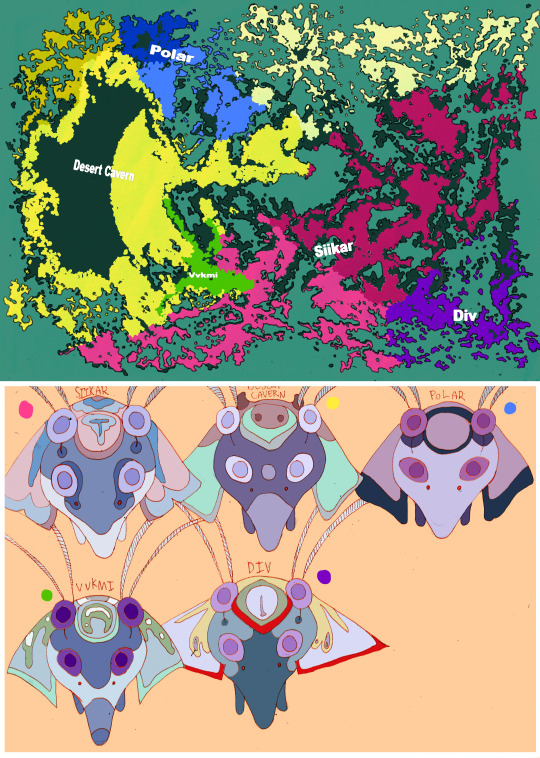
grik krog ("over the mountain" in kkarikiko)

*(these are largely political groups as opposed to genetically distinct groups. like humans, there is a huge amount of genetic diversity and interminging between geographic groups. these images are based on beauty standards and stereotypical depictions.)
#speculative biology#alien species#xenobiology#kkariko tag#worldbuilding#oc#sci fi#the divisions in color represent different culture groupings within the larger ethnic groupings#so for example. western flats as a term includes rikka cultures sinyarr cultures fori cultures and garriko cultures#(rrikrik is from a rikka culture) (karra is from a mikrikka (central) culture)#and the dark teal ground on the grik krog and mikkriko maps represent areas where those two species do not live#mikkriko live underground in cave systems. so they dont live where there arent caves#and grik krog are largely isolated in the west due to the huge big mountain range which created the western flats#grik krog arent very good at climbing mountains or swimming so they dont live on islands either
10 notes
·
View notes
Note
Heya, multiple questions. May have actually asked this before in private but: It's called milky federation, how exactly is it set up? And are there other such big galactic powers?
Also on an entirely different note and more mundane, how are travel times in the Galaxy? Is it feasible to say, get a 2 week vacation, spend it a few systems over and then come back in time for work again?
Here's a fun idea I had that'll help me explain the travel times. A version of underground maps but with wormholes. Not final, just wanted to do a first try, I like it.

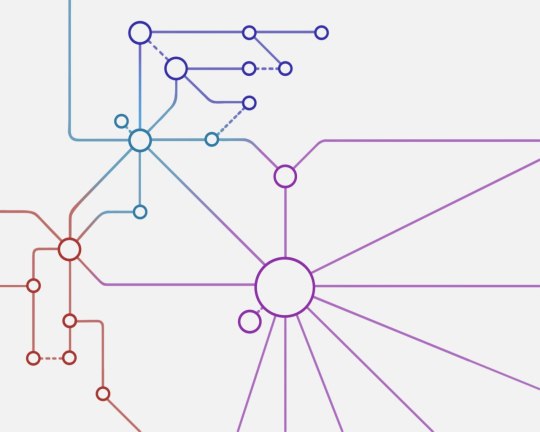
You can ABSOLUTELY go to a different system for vacation, you just have to go through the Hole security in the Hole Station (I find the idea of wormholes being called "Holes" hilarious).
The obvious problem with this is that it unfairly favours capitals and important places. Since there's no FTL travel, you might travel faster to the MF's capital than gran's house, which you can see with a telescope. This is very frustrating to those who live in the periphery of stations.
As for the MF, it is an interplanetary political and economic union of sophont species with its origin and main activity in the Milky Way.
It follows an ideology of pragmatic socialism. Every member must provide basic rights to its citizens, not because it's the right thing to do, but because if people are unhappy, they riot.
It's main strategy is being "the Good Guy" in the universe, specially compared to other unions (which we know exist but barely know anything about, except that they are not as good).
That being said they are not above having non-democratic regimes as members, and they keep economic ties with morally questionable non-members. They'll cut ties or organize a coup if the people start showing discontent, in the end they're always the hero.
12 notes
·
View notes
Text

E singer specific folk outfit for the rainy season celebration in the central west coast, worn by adults running the festivities. The yellow accents make it special due to how expensive yellow fabric dye is in that region.
243 notes
·
View notes
